
Sunday December 20, 2020 | NATIONAL [Update: 5:20 pm December 20, 2020]
by Mary P Brooke, B.Sc, editor | Island Social Trends
A new strain of the SARS-CoV-2 coronavirus (aka COVID-19) has been sweeping across southern England. Several countries in Europe have already restricted incoming travel from the UK and Christmas shopping and gatherings in southern England must be cancelled because of rapidly spreading infections blamed on the new coronavirus variant, it was announced by British Prime Minister Boris Johnson this weekend.
[Update at 5:20 pm Sunday December 20: Canada has suspended incoming flights from the United Kingdom, in light of a new COVID strain during this second wave of the pandemic. All commercial, private and charter flights transporting passengers from the U.K. will be suspended indefinitely as of midnight tonight. The restriction doesn’t apply to cargo flights, aircraft landing for safety reasons or flights that land for technical stops where no passengers disembark. The decision followed an afternoon meeting of a group of cabinet members and senior government officials who convene as the Incident Response Group (IRG).
Here in Canada, where the immunization process got started just this past week with the first available vaccine product (an mRNA type) from Pfizer, the question is being asked as to whether the existing vaccine(s) … with another mRNA type expected soon from pharmaceutical manufacturer Moderna … will provide as much immunity as is expected against the original genetic code of the COVID-19 virus.
On CBC today, highly regarded infectious diseases specialist Dr Isaac Bogoch said that ‘probably’ is the answer to that question. He said that carefully, based on what he’s heard from virologists in recent days.
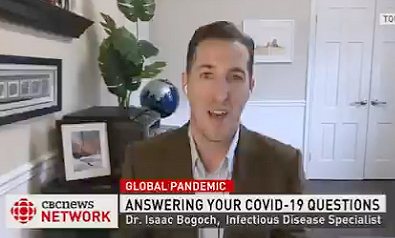
Genetics of the new strain have been worked out, but the new strain is still being observed as to “how it behaves in real world settings”, said Dr Bogoch in an interview with CBC’s Natasha Fatah. “There are still a lot of unanswered questions.”
Key questions about the new strain of the virus are:
- Is this new strain more transmissible;
- does this potentially cause a more severe infection; and
- will the (present) vaccine(s) work against it.
Some data is apparently pointing in the direction that the new strain is in fact more transmissible, Dr Bogoch said. That puts a whole new spin on the second wave of the COVID-19 pandemic this winter of 2020 (and into the new year of 2021), that is already surging past the impact of the first wave of spring 2020.
It’s not likely to cause additionally severe illness, but there is no way to really know at this point, as the variant is fairly recent and data is limited, Bogoch explained.
Taking a cautious approach:
A cautious approach is “completely appropriate”, said Bogoch in the context of other countries banning incoming travel from the UK at this time. Canada already has some travel restrictions in place (requiring 14-day quarantine for anyone who comes into this country, for example). Further restrictions (to the degree of a ban) on incoming travellers from the UK (and Canadians heading to the UK for that matter) are a possible option. Or at least adhering to further strict measures around exposure to anyone who has arrived from the UK (beyond the 14-day quarantine), such as closer followup by contact tracers during quarantine, insisting people stay in hotels away from others, and screening at the airport point of entry, said Bogoch.
The variant might also “all amount to nothing”, he said, but quickly adding that precaution is of course prudent because “there is so much on the line”. That the virus might be “more transmissible” is his top concern overall regarding the new strain.
Dr. Isaac Bogoch is a staff physician at University Health Network, clinical investigator at Toronto General Hospital Research Institute, and associate professor at University of Toronto. Dr. Bogoch works with an international and interdisciplinary team that models emerging and re-emerging infectious global health threats. As of December 4, he is one of 10 appointees to the Ontario government’s Ministers’ COVID-19 Vaccine Distribution Task Force which also includes General Rick Hillier (retired) on logistics.
More spikes, more damage:
By now, most people are aware of the basic appearance and structure of a coronavirus. The virus is microscopically small (generally 0.125 microns), generally round in shape, with a number of projections (spikes) on its surface. The spikes of the COVID-19 virus attach (bind) themselves to human cells, and through that use the human cells as a cozy incubator for reproducing itself.

The most evident result of this biological action is cell destruction (particularly in the lungs where the virus generally arrives first via bronchial passages) and a resultant reduction of oxygen supply to the human host. In short, those who die of this disease effectively succumb to suffocation.
Viruses with a mutation to having more spikes (as many as four to five times more) “were much more infectious than those without the mutation in the cell culture system we used,” according to a Scripps Research virologist Hyeryun Choe, PhD, senior author of a study done earlier this year. The mutation had the effect of markedly increasing the number of functional spikes on the viral surface.
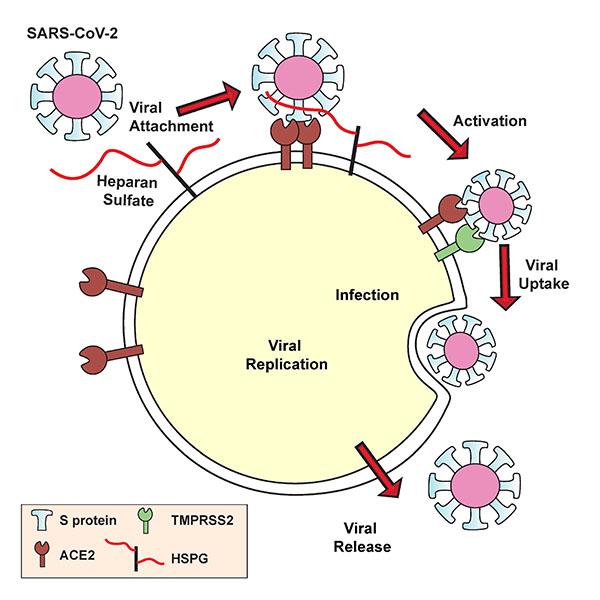
Size matters:
The very small size of the COVID-19 virus (of any variation) is of concern because of how much protection (e.g. use of N95 masks) that it takes to prevent it from entering our airways (via mouth, nose or eyes).
COVID 19 virus particle size is generally 125 nanometers (0.125 microns); the range is 0.06 microns to .14 microns. The N95 mask filters down to 0.3 microns; this would seem to suggest that even the medical-grade N95 masks do not block all viral particles.
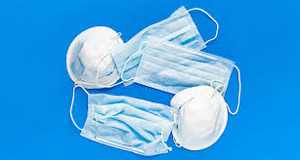
However, the COVID-19 virus is always bonded to something larger. The virus attaches to water droplets or aerosols (i.e. very small droplets) that are generated by breathing, talking, and coughing — as occurs when people share airspace (particularly at close proximity). The droplets consist of water, mucus protein and other biological material and are all larger than 1 micron. Breathing and talking generate particles around 1 micron in size, which will be collected by N95 respirator filters with high efficiency, say experts.
For a visual comparison, a human hair is typically 60 to 120 µm (micrometres, or microns) in diameter; for comparison, about 400 to 1,000 SARS-CoV-2 particles could ‘fit’ into the width of a single human hair. How effective is your home-made mask with respect to this? The answer to that question reinforces the importance of physical distancing and staying home and away from others during the winter indoor season.
Watching this in BC:
During this pandemic year, BC Provincial Health Officer Dr Bonnie Henry has taken media questions about variation of the SARS-CoV-2 virus. Overall, she has not indicated any specific or additional concerns. That’s in the context that the BC Centre for Disease Control (and the BC Health Ministry) is already confident with the efficiency of its contact tracers and testing protocols.
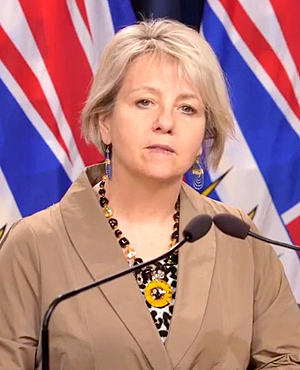
BC CDC does note the type/strain of the virus when testing people for COVID-19. In BC the approach has been to mostly test only people who are showing symptoms of the COVID-19 infection.
Wide-spread testing of asymptomatic people has been generally viewed by Dr Henry as not efficient for finding active cases, and generally speaking might be wasteful of the resources that go into the test kits that are of course hoped to be in reliable supply at any given time.
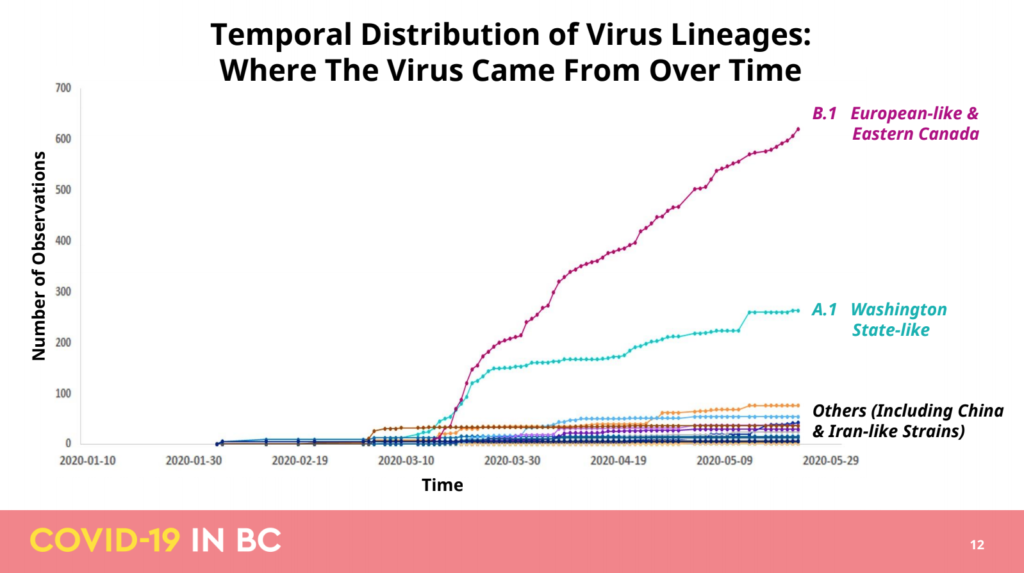
Back in June Dr Henry said: “The virus’ genome changes over time. This one is not as fast a changer as influenza but it changes at about two base pairs per month. But that is enough that we can tell the origin of where it came from.” She presented some data to that effect.
The most recent data modelling (dated November 12, 2020) did not include a graph about variant strains.

Next COVID data modelling in BC:
The next data modelling presentation by Dr Henry is scheduled for this coming week, on Wednesday December 23. That’s usually at 3 or 3:30 pm, livestreamed on Twitter, Facebook and YouTube (and then reposted by the BC Government in various social media channels).
===== LINKS:
No incoming passenger flights into Canada from UK as of midnight December 20, 2020 (December 20, 2020)
Latest BC & Vancouver Island COVID case update (December 18, 2020)



